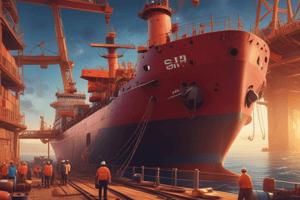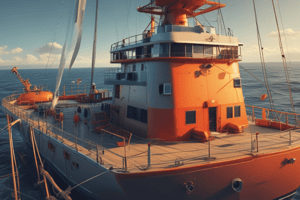Podcast
Questions and Answers
What are the principal structural parts of a ship?
What are the principal structural parts of a ship?
Hull, superstructure, bulkheads, decks, rudder, propeller, and thrusters.
What is the importance of minimum safe manning on a ship?
What is the importance of minimum safe manning on a ship?
It ensures safe operation and effective coordination among crew members.
The ______ is responsible for the ship's navigation and handling.
The ______ is responsible for the ship's navigation and handling.
seaman
Which of the following is NOT a principal structural member of a ship?
Which of the following is NOT a principal structural member of a ship?
Seamanship includes knowledge of rope work, knots, and splicing.
Seamanship includes knowledge of rope work, knots, and splicing.
Name two specific types of propulsion systems found on ships.
Name two specific types of propulsion systems found on ships.
What are the main features used to describe the dimensions of a ship?
What are the main features used to describe the dimensions of a ship?
Flashcards are hidden until you start studying
Study Notes
Course Overview
- Subject: Seamanship 1 - Ship and Ship Routine and Construction
- Academic Year: 2024-2025
- Instructor: 2/O Jake D. Lavarejos
- Units: 4 (3 hours lecture; 1 hour laboratory)
- No prerequisites required for enrollment
Course Objectives
- Gain an understanding of the ship's principal structural members, their characteristics, functions, and contributions to seaworthiness.
- Learn to construct a functional chart of shipboard organization adhering to minimum manning requirements.
- Familiarize with essential maritime terminology and the significance of various ship components.
Key Topics and Lessons
-
Lesson 1: Features and characteristics of structural members
- Focus on location and their contributions to the vessel's seaworthiness.
- Includes principal structural parts, ship dimensions and forms, and characteristics of different ship types.
-
Lesson 2: Identification of principal ship dimensions
- Learn terms such as Length Overall (LOA), Length Between Perpendiculars (LPP), Breadth, and Depth.
-
Lesson 3: Minimum safe manning concept
- Understand its importance in the safe operation of a ship and compliance with regulatory standards.
-
Lesson 4: Working departments of a cargo ship
- Define functions relevant to ensuring operational safety and crew welfare.
-
Laboratory Activity: Practical drawing and labeling of the principal structures of different ship types.
Important Concepts
- Seamanship: Skills necessary for effective navigation and operations at sea, including navigation techniques and the art of marlinspike seamanship which entails rope work and knot tying.
- Ship Construction: Knowledge of various ship components and structural elements that ensure the vessel's integrity and operational efficiency.
Vessel Structural Features
- Principal Structural Parts: Examination of the hull, superstructure, and internal support structures.
- Bulkheads: Understand the functions and importance of different types of bulkheads (watertight, fireproof) to maintain structural integrity.
- Propulsive Elements: Study of rudders, thrusters, and propellers, focusing on their design and operational roles.
Learning Outcomes
- Identify and explain the features and characteristics of a ship's structural members.
- Recognize the significance of minimum safe manning in maritime operations.
- Visually depict and label principal ship structures according to their respective functions.
Studying That Suits You
Use AI to generate personalized quizzes and flashcards to suit your learning preferences.




